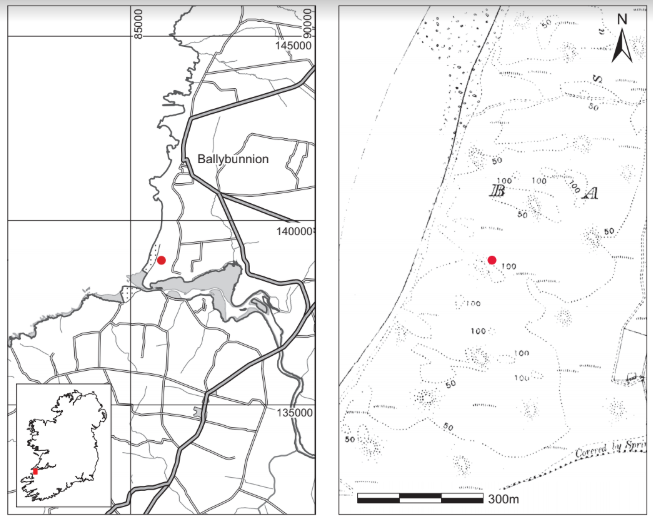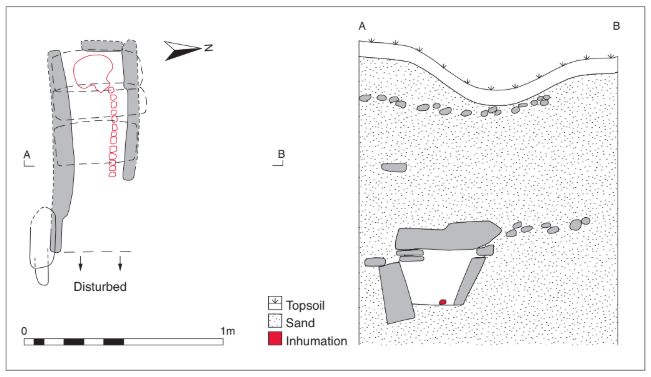County: Kerry Site name: BALLYEAGH, CO. KERRY
Sites and Monuments Record No.: SMR KE004-062 Licence number: E1076
Author: MARY CAHILL
Site type: Iron Age and early medieval graves, c. 300 BCc. AD 1200
Period/Dating: —
ITM: E 485818m, N 638977m
Latitude, Longitude (decimal degrees): 52.490248, -9.681356
Introduction
In July 1979 a lintel grave containing an inhumation burial was discovered by children playing in the sand-dunes at Ballybunnion, Co. Kerry. The cist was found with the skeleton slightly projecting through a partly eroded sand-dune at a depth of 0.9m below ground level. The girls, Deirdre Walsh and Vivienne and Lilian Nolan, reported the discovery to their parents; because of the incredulity expressed, they returned to the site and removed some of the bones, including the skull. A doctor visiting the local golf club identified the remains as human and probably as those of a young male. The bones were removed to the Garda Station at Ballybunnion. The site was reported to the NMI by the Gardaí at Ballybunnion, but in the meantime the site was visited—and disturbed—by many locals. A rescue excavation was undertaken by Mary Cahill, assisted by Anne O’Dowd. The human remains were examined by Professor C.A. Erskine.33
Location (Fig. 4.14)
The site was in the townland of Ballyeagh, approximately 1km south of Ballybunnion, northwest Co. Kerry.34 It was in sand-dunes approximately 30m from the shore at an altitude of 0–30m above sea level. The area is known locally both as ‘shell valley’ and ‘the boneyard’. A large number of artefacts have been recovered from the sandhills in the area over the past century,including a Roman coin (Hadrian, AD 117–138), worked flint, bronze pins and bone pins. Another long cist was later found in the neighbouring townland of Ballybunnion and was excavated by Raghnall Ó Floinn in 1987. The site at Ballyeagh now lies underneath a golf-links.
Description of site
The cist was rectangular in plan with its long axis aligned east/west. It was exposed in section and only a portion survived. Internally the extant area measured 1m long by 0.3m wide by 0.27m high (Fig. 4.15).

It was made up of two edge-set side slabs (one at each side), a western end stone and three lintels. The southern side slab measured 1m in length and projected considerably beyond the northern side stone, which measured 0.64m long in the section and leaned markedly outwards from its base. On both sides small flat flags had been placed between the walls and the capstone. Three capstones or lintels rested on the side walls of the cist. Those closest to the western end overlapped slightly. The floor of the cist was not paved.
The cist contained the upper portion of an articulated skeleton of an adult female (1979:81), and no accompanying artefacts were found. The body was lying west/east, and from the impression left on the floor of the cist the skull was located in the south-west corner of the cist, with the spine slightly curved towards the northern side. It was not possible to state with certainty that the body was extended, as the lower portions had been disturbed and most of the leg bones were removed. Nevertheless, the narrowness of the cist would seem to suggest that this was an extended inhumation, as it would not have been possible to place a crouched burial in such a small space.
Comment
A sample of the human remains was submitted for radiocarbon dating and yielded a date of 1455±45 BP, which calibrates to 470–663.35 Given the fact that the area was known locally as ‘the boneyard’, it is likely that there were also other burials in the area. The radiocarbon date for this burial suggests that lintel graves may have been in use somewhat earlier than has been suggested by O’Brien (2003, 67).

HUMAN REMAINS
C.A. ERSKINE
The collection (1979:81) comprises the nearly complete, well-preserved skeleton of one adult female. Height: 160cm. Skull: basal parts of occipital bone missing, otherwise nearly complete, including mandible; teeth show little wear.
Vertebral column: complete; very well preserved.
Ribs nearly complete.
Sacrum: complete, with one piece of coccyx.
Sternum complete.
Scapulae: fragments. One left clavicle.
Long bones complete (one humerus in two fragments).
Hand bones: twelve carpal bones, nine metacarpal and 21 phalanges.
Lower limb: one iliac bone complete, right pubic bone missing. Long bones complete and well preserved: left tibia in two pieces; left fibula in three pieces; right fibula in two pieces; nine tarsal bones; ten metatarsals; five phalanges present.
33. A week after the excavation, Lilian Nolan, one of the finders, rang to report the discovery of a second cist bya local who deliberately went searching for it. It had since been covered up by the Gardaí, however, and it was decided to leave investigation of the cist to a later date.
34.Parish of Killehenny, barony of Iraghticonnor. SMR KE004-062——. IGR 085843 138930.
35.GrA-24498.